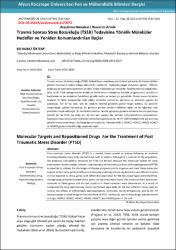Travma sonrası stres bozukluğu (TSSB) tedavisine yönelik moleküler hedefler ve yeniden konumlandırılan ilaçlar
Citation
Kubat Oktem, E. (2023). Travma Sonrası Stres Bozukluğu (TSSB) Tedavisine Yönelik Moleküler Hedefler ve Yeniden Konumlandırılan İlaçlar . Afyon Kocatepe Üniversitesi Fen Ve Mühendislik Bilimleri Dergisi , 23 (2) , 532-546 . DOI: 10.35414/akufemubid.1173072Abstract
Travma sonrası stres bozukluğu (TSSB), fiziksel hasar veya kaygı gibi zihinsel şok içeren bir kazayı takiben görülen travmanın neden olduğu zihinsel bir hastalıktır. Toplumda yaygın olmasına rağmen, TSSB'nin prognozu ve optimal terapötikleri sınırlıdır. Erken müdahale için moleküler hedefler belirsiz kaldığından, daha iyi bir TSSB patogenezinin moleküler temellerinin anlaşılması hastalık prognozunun zorluklarını karşılamak ve bu moleküler hedeflere yönelik teşhis ve tedavi için gereklidir. Strese maruz bırakılan farelerin iki farklı dokusundan elde edilen mikrodizi verilerinin işlenmesi ve analiziyle yapılan bu çalışmada, her iki tip doku için de anlatımı farklılık gösteren genler tespit edilmiş, bu genlerin zenginleştiği yolizleri bulunmuş, bu genlerin protein protein etkileşim ağları ve bu ağlardaki hub proteinler tespit edilmiştir. Bu hastalıkta anlatımı farklılık gösteren genlerin etkilerini tersini çevirmeye yönelik her iki farklı tip doku için de ayrı ayrı yapılan ilaç yeniden konumlandırma çalışmalarının karşılaştırılması sonucunda; vorinostat, homoharringtonin ve QL-XII-47 TSSB’yi iyileştirmek için yeni ilaç adayları olarak önerilmiştir. Bu ilaçlardan vorinostat’ın, hücrede HDAC1, HDAC2, HDAC3, HDAC6, HDAC7 ve HDAC8 genlerini hedef aldığı tespit edilmiştir. Post-traumatic stress disorder (PTSD) is a mental illness caused by trauma following an accident
involving physical injury or by mental shock such as anxiety. Although it is common in the population,
the prognosis and optimal therapies for PTSD are limited. Because the molecular targets for early
intervention remain unclear, a better understanding of the molecular basis of the pathogenesis of PTSD
is essential to address the challenges of disease prognosis and to diagnose and treat these molecular
targets. In this study, performed by processing and analyzing microarray data from two different tissues
of mice exposed to stress, genes with differential expression for the two tissue types were identified,
the signaling pathways in which these genes are enriched were found, the protein-protein interaction
networks of these genes and the hub proteins in these networks were determined. As a result of
comparing the drug repositioning studies performed separately for the two different tissue types to
reverse the effects of differentially expressed genes, vorinostat, homoharringtonine, and QL-XII -47
were proposed as novel drugs for the treatment of PTSD. Vorinostat, one of these drugs, was also found
to target HDAC1, HDAC2, HDAC3, HDAC6, HDAC7, and HDAC8 genes in the cell.
Source
Afyon Kocatepe Üniversitesi Fen ve Mühendislik Bilimleri DergisiVolume
23Issue
2Collections
- Cilt 23 : Sayı 2 [25]



















